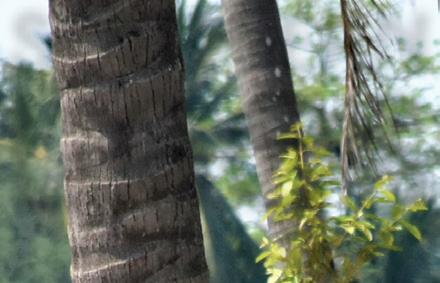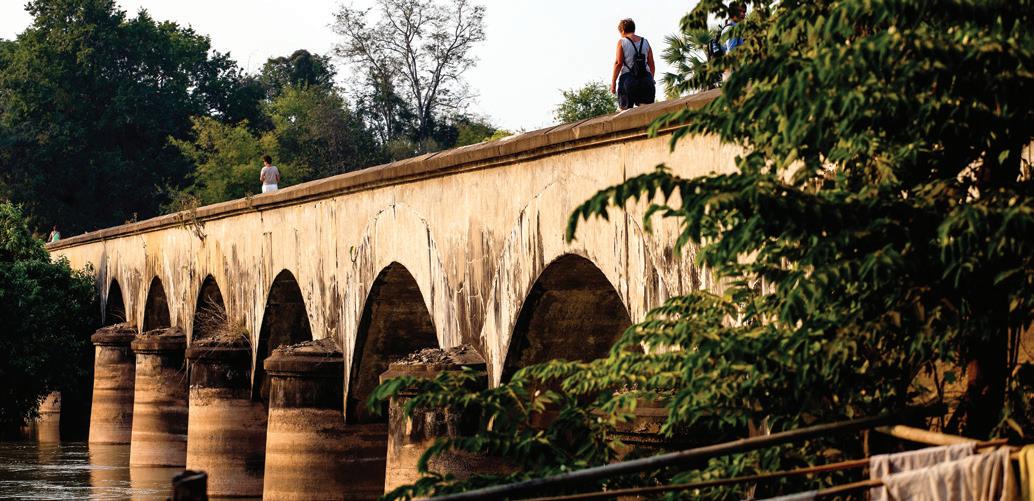
7 minute read
Southern Laos – The Secret Lives of Islands


Advertisement

TEXT BY ROSEMARY MURPHY & BOUN SAIYAVONG PHOTOGRAPHS BY SWISSCONTACT / BART VERWEIJ
Cycling along the Mekong on Don Det with Don Khone bungalows visible across the river
Tropical islands are curious places, symbolizing for many the ultimate escape – abandoning everyday life for lush, sun-drenched, exotic surreality. For a landlocked country, Laos is surprisingly rich in islands. In the south, the Mekong swells to 14km wide, revealing a riverine archipelago, the Si Phan Don, or 4000 Islands. Only a few are inhabited, and 4000 may not be entirely accurate. But from my riverside table in Paradise, a restaurant on Don Det serving a spicy fi sh soup, fragrant with lemongrass and fresh pineapple, I count 8, ranging from the minute, essentially just big rocks, to those large enough to host several villages.
I’ve visited Don Khone and Don Det, the most popular tourist destinations, several times now and keep returning. I love the ease of getting here, enjoying entire days outdoors, and becoming a regular at my favorite cafés (try Chez Fred and Lea and Somphamit Guesthouse). And I love cycling the breezy trails tracing the islands’ perimeters. The narrow, well-worn routes are like a portal back to childhood, exploring pine-needled paths in the woods of Nova Scotia. In Si Phan Don, the sandy paths are bordered by palm trees, and fragrant with tropical fl owers, mango, jackfruit, and tamarind trees, but the feeling is the same; an easy, almost blissful state, marveling at each little wonder encountered en route.
Helpful cycling maps, posted on the islands and easily downloaded, illustrate the available routes, marking guesthouses, restaurants, and attractions – where to catch the boat to see endangered Irrawaddy dolphins, the best views, swimming spots, and which paths are shaded or not – crucial information when the sun hits full strength. There is always a spot nearby to rehydrate with a fresh coconut and should you encounter bike trouble, someone is always happy to help.
My advice? Test out a few different bicycles – there are many on offer for as little as 10,000 kip per day. Rent your bike for several days at a time, avoiding the hassle of returning it each night or hustling to claim it again the next morning. Hop on and relax, following well-worn laneways through sleepy villages of stilted houses and tidy kitchen gardens, past the rice fi elds, and through dense jungle with leaves bigger than your head and vines like boa constrictors. You’ll encounter chickens, cows, buffalo, dogs, tuk-tuks and motorbikes, perhaps a mobile Lao party blasting traditional music; but no cars, no ATMs. Too hot? Head for the shade huts at Li Phi Falls. Stretch out on colorful mats, sip a fruit shake, grab a bite, and dart down to the gold-fl ecked sandy beach for a dip. Settle yourself somewhere lovely for sunset.
The sky explodes in color: fi ery oranges, pinks, and mauves mirrored in the water where children splash and bathe as their parents wash clothes in the river.
The Mekong is the lifeblood of the archipelago; the source of food and livelihoods, the means of transportation and connection, but it also defi nes the island’s limits. Island life is a closed loop – the ultimate microcosm – one becomes keenly aware of self-suffi ciency, and its opposite. Just as anything not produced on the island must be brought in by boat, anything that can’t be consumed or reused must be shipped out again. Where potable water doesn’t fl ow from taps, plastic bottles are ubiquitous, so it’s heartening to see free water bottle refi ll stations popping up. So far, 14 hotels and restaurants have set up stations as part of Southern Laos’ Refi ll Not Landfi ll campaign. Here’s hoping they inspire everyone to carry reusable bottles and help preserve the 4000 Island’s Arcadian charm.
If you wish to delve deeper into everyday life on a real tropical island, I highly recommend the half-day River Life Experience tour ($50/person). Weaving our way upriver between islands, 40-minutes fl y by as our guide, Mr. Jay, describes life on Don Loppardi, our destination. We disembark at Nakhone Noi, one of the island’s main villages, greeted by colorful stupas and energetic children. Mr. Jay leads us through the tranquil temple grounds explaining tasks assigned to novices like the saffron-bundled

GETTING THERE Lao Airlines has regular fl ights to Pakse from Vientiane, Luang Prabang, and Bangkok. Nakasong is located 144km south of Pakse. Buses depart daily from Pakse to Nakasong. Taxis are available through many travel companies in Pakse. In Nakasong, boat taxis depart for Don Det and Don Khone and tickets can be purchased at the pier.
1
boy napping in the shade. We continue our way through the village, encountering several unique characters in the colorful, close-knit community. The village chief plays electric piano outside a shop offering everything from construction materials to buffalo skin jerky. Mr. Air explains the alchemical trick of turning sticky rice into potent but surprisingly smooth Lao Lao whiskey with samples given! Mama Bounmee, deftly weaves complex and colorful sticky rice baskets, while conversing and directing activity, rarely glancing at the bamboo strips in her expert hands. She slows down so I can attempt weaving a few bands too. And I fi nally learn how to cook sticky rice, tossing the glutinous grains in their elegant steamer basket.
We return to water’s edge to try traditional fi shing techniques; tossing handmade gill nets weighted with chains and cleaned to near-invisible with fermented tamarind shells. We even catch a baby pufferfi sh! Digestion primed with a few shots of Lao Lao whiskey, we feast on barbecued fi sh, including a few tiny ones we’d plucked from the river, the sticky rice we made, and spicy papaya salad. I asked Mr. Jay, whose thoughtful interpretation added so much to our experience, what was most meaningful to him about island life, he responded immediately, “number one for me, seeing the way of living of the local people. They make so many things for themselves from nature, their skill is amazing.” Heading back downriver, I feel exceptionally lucky to have had such genuine and illuminating encounters with the very real people living their everyday lives on the islands of our tropical fantasies.
MORE INFO Find Southern Laos’ refi ll sites at refi lltheworld.com or get the Refi llMyBottle app
Download 4000 Island’s cycling maps at southern-laos.com
The River Life Experience directly compensates the villagers for their time and expertise, and can be booked by contacting Green Paradise (with Mr. Jay), at greenparadisetours99@gmail.com, phone: (856-31) 214 842, mobile: (856-20) 9953 3939, or Wonderful Tours at (+856 (0) 20 9759 8666). Scan the qr code for more info
Photo: Sommith Punyathone

P h o t o : R o s e m a r y M u r p h y
5
1. The French Bridge linking Don Det and Don Khone 2. Hammocks overlooking the Mekong at Don Det tourist bungalows 3. Mama Bounmee demonstrates how to cook sticky rice, Don Loppardi 4. Mr Jay, tour guide, and Mr. Serm, boat man with Green Paradise 5. Mekong Puff er Fish, aka Pignose Puff erfi sh or Arrowhead Puff erfi sh 6. Cyclists surveying the cycling map at Don Khone
4

3


小岛上的秘密生活
翻译 : 航 图片来源: SWISSCONTACT / BART VERWEIJ
热带岛屿是神奇的地方,这里象征着逃亡的终点。对于一 个内陆国家,老挝拥有众多岛屿。 在南部,湄公河宽度可 达14公里,展现出一条岛屿裙带--西潘敦群岛,也有人称 之为四千美岛。 岛屿上鲜有人居住,4000 也不是一个准 确的数字。但是从我坐在唐德岛(Don Det)岛河边,数到 了8座小岛,有的小几乎看不出岛,也有的大到可以容纳 几座村庄。 最受欢迎的Don Khone和Don Det岛,我去了几 次,并且总心之向往。我喜欢那里的轻松环境,在户外享 受一整天,去我最爱的咖啡馆。而且,我喜欢沿着小岛蜿 蜒的小径骑行。在Si Phan Don,沙质小径以棕榈树为边 界,空气中飘着热带花卉,芒果,波罗蜜和酸角树的芬芳, 愉悦至极。 骑行地图张贴在岛屿的各处,也可以在网上下载。地 图上清楚标记了路线,旅馆,饭店和景点‒在哪里乘船可 以看到濒临灭绝的伊洛瓦底海豚,观景点,游泳点以及哪 些路径比较阴凉,哪些路线阳光灼热。附近总能找到可以 买到新鲜椰子的地方。如果您的自行车遇到问题,总会有 人乐意为您提供帮助。 我的建议? 试一下不同的自行车—自行车的租赁费 大概在10000基普每天。一次可以租用几天的自行车,避免 了每天晚上归还自行车或第二天早晨再去租车的麻烦。沿 着破旧的巷道,穿过昏昏欲睡的小房子和整洁的菜园,穿 过稻田,穿过茂密的丛林,随处放松。 太热? 去Li Phi 瀑布 乘凉吧,在色彩缤纷的垫子上舒展身体,吸一大口水果奶 昔,然后去金色的沙滩玩耍,游泳。 日落的时候,随处停下 欣赏,天空的颜色好像大爆炸:火红的橙色,粉红色和淡紫 色映在水面上,孩子们在水里嬉闹着,父母在河边洗衣服。

更多信息: 访问www.refi lltheworld.com,可以 找到老挝南部的蓄水站,也可以下载 上找到Refi llMyBottle APP 在www.southern-laos.com下载 4000美岛的自行车地图 “河流生活体验”套餐的收益会 直接补偿给村民。可以通过Green Paradise(杰伊先生)联系预订,电 子邮件为greenparadisetours99@ gmail.com,电话:(856-31)214 842 手机:(856 -20)9953 3939,或致电 (+856(0)20 9759 8666)。 扫描二 维码以获取更多信息。
到达: 老挝航空有从万象,琅勃拉邦 和曼谷到巴色的航班。 Nakasong位 于巴色以南144公里。 每天都有巴士 从巴色出发前往Nakasong。可以通 过巴色的许多旅行社预定出租车。 在Nakasong,乘坐摆渡船前往Don Det和Don Khone,可以在码头购买 门票。有抵达巴色的航班。 上图: 游客参加“湄公河体验”团
湄公河是群岛的命脉,实物和供给的来源,交通和联系的渠 道,同时,它也定义了岛屿的的范围。 岛屿生活是一个封闭的循 环--最终的缩影是有的人意识到自给自足的生活方式很必要,而有 的人则恰恰相反的意识到在社会大熔炉里的重要性。岛上没有生 产任何东西,都必须用船运进来一样,任何无法消耗或重复使用的 东西都必须再次运出。 在没有饮用水的地方,塑料瓶无处不在,因 此很高兴的看到免费的蓄水站已经开始在岛屿上出现。 到目前为 止,作为老挝南部的“再利用,不填埋垃圾”活动的一部分,已有14 家酒店和餐馆设立了蓄水站。 希望他们能激发大家携带可重复使 用的瓶子,并帮助保护4000岛的自然魅力。 如果您想深入了解一个真正的热带岛屿上的日常生活,我强 烈建议您参加半天的河上生活体验之旅(每人50美元)。杰伊先生, 我们的向导,想我们介绍我们的目的地Don Loppardi的生活,我 们沿着岛屿之间的向上游游览,40分钟转瞬即逝。我们在该岛的 主要村庄之一Nakhone Noi下船,那里色彩缤纷的佛塔和欢闹的 孩子们在等待着我们。杰伊先生带领我们穿过宁静的寺庙,向新手 们讲解寺庙礼仪。我们继续穿过村庄,在村里遇到了几个有意思的 人。村长在一家商店外面弹奏电子琴,商店内销售各种各样的东 西,有建筑材料,也有水牛皮。Air先生向我们讲解了怎样用糯米制 作浓烈的老挝威士忌,还给我们品尝。Bounmee妈妈巧妙地编织 着五颜六色的糯米篮子。她放慢编制的动作,让我们也尝试编制了 几下。我们还学习了如何用蒸笼煮糯米。 我们回到水边尝试传统的捕鱼技术—将手工网扔到河里。我 天,我们竟然捉到了小河豚! 又喝了几杯老挝威士忌,我们开始 享受美味的烤鱼,包括几条我们自己从河里钓上来的小鱼,就这 糯米饭和凉拌青木瓜,酸辣可口。我问杰伊先生,因为他的详细讲 解给我们的旅途增加了很有乐趣和知识,但我也很好奇,岛屿上 的生活中对他来说最重要的部分是什么。他立即回答:“对我来 说占第一位的事看到了当地人民的生活方式。 他们从自然界的 馈赠为自己创造了很多东西,他们的技能令人赞叹。” 回到路上, 我感到非常幸运,能够看到真正在热带岛屿上生活着的真真切切 人们。










